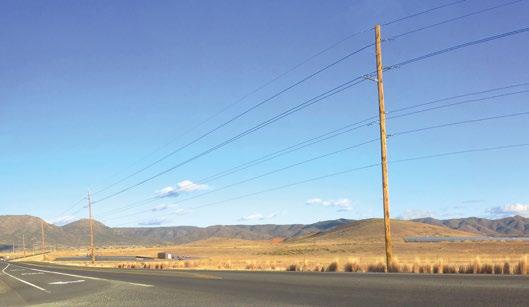
6 minute read
The 1874 Solar Project
By Angie Johnson-Schmit
The Fains Spur Solar Development in Prescott Valley.
- Thomas Edison
As Arizona turns to clean, sustainable electricity sources, solar energy has become a first choice for many communities. With an average of 273 sunny days per year and relatively flat terrain, Prescott Valley, Arizona has a lot of advantages for a solar project. Committed to building and supporting community, family and the environment, the Fain family recognizes the value of bringing sustainable energy to the area. Solar power was the logical choice.
The Fain family first partnered with Arizona Power Developers (AZPD) to explore the potential for bringing solar power to the region. Once viability was affirmed, they sought out a larger, more experienced development partner. With over 30 utility-scale solar, wind and pumped storage hydro projects under their belt, renewable energy development company rPlus Energies fit the bill. Out of that partnership, the 1874 Solar project was formed.
Named for the year the Fain family first arrived in Arizona, the 1874 Solar project will bring utility-scale solar power to the Prescott Valley area. The Fain family has worked this land for generations. “We were looking to continue to use the land,” said Brad Fain. “That’s what we’ve done for 140 years.” This project will continue that tradition while also fulfilling his father’s vision of building a vibrant community.
Solar developers looking to build a utility-scale project have plenty to consider when choosing a location. Before any solar site is chosen, an array of project requirements must be investigated, including geological makeup and potential environmental impact. A section of the Fain family-owned Rafter Eleven Ranch in Prescott Valley checked all the boxes for rPlus Energies.

Before
Can you spot the difference?
Designed for low visual impact, the 1874 Solar project will blend into the natural landscape.

After
The 600-acre solar project is expected to have a positive economic impact on the community. Construction is scheduled for 2022 or 2023, and the 1874 Solar project will create about 200 construction jobs. On completion, the 1874 Solar project will generate enough electricity to power approximately 20,000 homes for the community.
After the initial assessments, feasibility study and system impact study came back positive, the 1874 Solar project moved forward. The Fain Signature Group and rPlus Energies signed an option lease, which allows rPlus to begin another round of studies and surveys. On Wednesday, January 6, 2021, the 1874 Solar project’s conditional use permit was approved by the Yavapai County Board of Supervisors.
For an area that counts beautiful vistas and outdoor recreation as key parts of life, solar energy is a great way to generate power with minimum environmental impact. The solar project will actually have a fairly low visual profile because of the type of photovoltaic panels that will be used.
“The benefit of the Fain’s property is that it’s a little bit more dry and has less vegetation, so our hope is that that’s going to provide us with a higher rate of albedo,” said rPlus Energies Development Analyst Tanner Kreger. Albedo refers to the rate at which the sun bounces off the land and back onto the back of the solar panels. Simply put, albedo measures how reflective the ground is. A good albedo rating means the bifacial, or two-sided, panels planned for this project can capture maximum sunlight from both sides.
Another big advantage is that the parcel is situated at an altitude of approximately 5,300 feet. Higher altitudes mean less particulates in the air, and with less atmospheric interference, it’s possible to capture more sunlight. Other benefits include the location’s southward sloping, no obvious red flags in terms of endangered species, and close proximity to the electrical grid.
For a utility-scale project that will be putting the electricity created directly onto the power grid, proximity is vital. “We have the transmission right off the highway there, which is definitely very useful for our project,” said Kreger.

The company plans to build a substation nearby to keep the distance from energy generation to energy uploaded to the grid as short as possible. A major reason why being close is so important is that electricity does not like to stay on power lines over long distances. “Think of the power grid as a bucket,” said rPlus Director of Development Rick Hamilton. “The electrons will go to the first place they can get out of that bucket, and the longer distance you transmit something, those electrons just fade off into the universe.” In addition to keeping the distances as short as possible, the power loss challenge is also met by raising the voltage of the power generated. “You can go longer distances with super high voltages and have fewer losses,” said Hamilton. To create that higher voltage, the process is an additive one.
Basically, the energy coming out of the photovoltaic panels is sent to a battery before going into an inverter to change it from direct current to alternating current. Then it is sent to a transformer which steps up the current on the internal grid before it is stored. Before uploading to the grid, the stored energy is sent to a substation where the electricity is run through another transformer before being placed onto the power grid.
“We’re providing clean power, which means a good sine wave” said Hamilton. “So being closer to the project means that the quality of electricity you have in the local area is improved.” For Prescott Valley, this will mean clean, reliable, and sustainable electricity that is locally generated.
The actual technology used for this kind of solar project is relatively straightforward. Essentially the project tech can be boiled down to bifacial photovoltaic solar panels, or modules, a central inverter, a tracking system, and lithium batteries. In addition, there are plans to build a small substation to put energy generated by the solar panels directly onto the nearby power grid.
Improved battery technology has taken down one of solar power’s biggest challenges. Solar power customers no longer have to worry about having access to power during the night or on Prescott Valley’s rare cloudy days. This project will likely use lithium battery banks to store that solar power so it can be added to the grid – or even scheduled in advance – when it is needed.

- Brad Fain
As battery storage technology has improved, the costs for large scale solar projects have dropped rapidly. This means a drop in cost for both straight solar and for stored solar power. New hydrogen battery tech is in development for very long duration storage, which will likely have a further effect on energy costs.
Another factor that helps keep solar energy costs down is the solid-state technology used. Other than the trackers that move the panels to face the sun and cooling fans on the inverter, there are “very, very few moving parts, including the storage,” said Hamilton. Fewer moving parts mean a more stable system that doesn’t require a lot of maintenance.
The Fain family sees putting sunshine, one of Arizona’s most abundant and sustainable resources, to work as a great way to honor the family ethos of supporting the Prescott Valley community. “As we go forward as a company, we try to live up to that standard that he (Bill Fain) established, that anything’s possible,” said Brad Fain. The 1874 Solar project is a big step forward for Prescott Valley’s sustainable, locally generated energy future.










